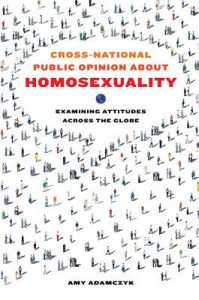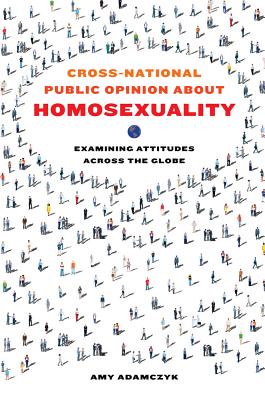 Cross-National Public Opinion about Homosexuality: Examining Attitudes Across the Globe
Cross-National Public Opinion about Homosexuality: Examining Attitudes Across the Globe
by Amy Adamczyk
University of California Press
304 pages, $39.95
SAME-SEX MARRIAGE is now legal in two dozen countries—while same-sex sexual behavior remains punishable by death in seven others. What accounts for the range of differences in acceptance of gay, lesbian, bisexual, transgender, and queer persons throughout the world?
In Cross-National Public Opinion about Homosexuality; Examining Attitudes across the Globe, sociologist Amy Adamczyk has woven an impressive tapestry of nuanced answers to this urgent and complex question. Her powerful if not entirely surprising conclusion is that religious salience—the importance people attach to religion—is the most important factor associated with reduced tolerance for homosexuality at the national level. Also implicated, but with the opposite effect, is the level of economic development along with the degree of democratic government.
Born on a dairy farm in rural Wisconsin, Adamczyk studied fashion design before turning to social science; she is now professor of sociology at CUNY’s John Jay College of Criminal Justice. Her well-organized findings and evidence-based conclusions are relevant for policy makers, legislators, and others working to increase tolerance in a fast-changing world. The text is packed with figures and tables, a wide-ranging bibliography, and detailed notes. In addition, many statements require careful qualification. Nevertheless, the researcher’s style is engaging, with inconsistencies in evidence treated as puzzles for which she offers possible solutions.
The national comparisons are presented in three tiers. The first is based on responses to the World Values Survey (WVS) that were gathered from nearly 200,000 people in 87 countries from 1999 to 2014 to explain differences in tolerance for LGBT people. The author probes results from nine countries using socio-historical data and content analysis from newspapers. Finally, she looks at tolerance in depth in one country, Taiwan, based on her own fieldwork.
A country’s level of tolerance is derived from the percentage of respondents who say that homosexuality is “never permissible” or that they would not want gay neighbors. About two-thirds of the variance among WVS countries can be explained by religious salience, per capita GDP, and the extent of democratic development. While the first of these factors was not unexpected, a surprising finding was that even nonbelievers living in strongly religious cultures hold attitudes similar to those of believers. Prosperity, on the other hand, tends to increase tolerance, as it enables people to raise their sights above everyday survival and experience a wider world than family or community. Similarly, democratic institutions tend to increase open-mindedness to the extent that a free press, freedom of association, and access to the media expose people to a wider cross-section of humanity.
Adamczyk’s nine case studies group countries by dominant religion—Catholic, Protestant, and Muslim—and focuses on three countries in each group. The three Catholic countries, Spain, Brazil, and Italy, were all found to be relatively supportive of LGBT rights. While some Catholic countries were less tolerant, these three also have in common a relatively free press. Predominantly Protestant countries include Uganda, South Africa, and the U.S., all of which combine a mixture of conservative and mainline denominations. Former British colonies all, they display widely divergent attitudes toward homosexuality, from Uganda’s draconian anti-gay laws to legal support for marriage equality in the other two countries. These differences in tolerance correlate with wide economic disparities: a GDP per capita of $46,000 in the U.S., $5,600 in South Africa, and $458 in Uganda. The latter country’s extreme poverty corresponds to a rural and insular social organization. For the third set, Adamczyk had intended to study three Arab countries, but the scarcity of WVS data forced her to examine three non-Arab Muslim nations: Malaysia, Turkey, and Indonesia. Even there, the data proved challenging to interpret, and she ends up calling for “more research” on this topic.
Like Arab Muslim countries, Chinese Confucian societies have had relatively little scrutiny. For this reason, as well as the availability of a research infrastructure, the author chose to study Taiwan, a country with Confucian and Buddhist strains but low religious salience, general prosperity, and a healthy press. How, then, to explain the relatively low level of gay tolerance? To explain this paradox, Adamczyk interviewed people whose jobs or activities gave them insight into how people there view homosexuality, including members of LGBT organizations. Her conclusion is that Taiwanese views of marriage and divorce, and the priority given to family structure, may reduce tolerance for homosexuality. In support, she cites the Confucian obligation to worship ancestors, with its emphasis on progeny and procreation. But if Taiwan’s fertility rate, now lowest in the world, is any indication, that obligation has weakened. Possibly Taiwan’s recent high court decision supporting marriage equality simply reflects the waning of traditional beliefs—in turn prompting a strong counterreaction led by the five percent of Taiwanese who are Christians.
Where are things headed? Looking around the world, Adamczyk finds that eighty percent of the countries examined are becoming more liberal. On the other hand, she cautions against premature optimism: “we can’t assume change will be linear or simple.” Most critically: “religion remains relevant.”
Rosemary Booth is a writer and photographer living in Cambridge, Mass.






